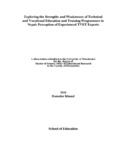Please use this identifier to cite or link to this item:
http://archive.nnl.gov.np:8080/handle/123456789/134| Title: | Exploring the strengths and weaknesses of technical and vocational education and training programmes in Nepal : perception of experienced TVET experts |
| Authors: | Khanal, Damodar |
| Keywords: | Technical and vocational education and training programmes--Nepal Technical education Vocational education Trainings |
| Issue Date: | 18-May-2018 |
| Abstract: | This study attempts to identify the strengths and weaknesses of technical and vocational education and training (TVET) programmes in Nepal as perceived by the TVET experts. It also seeks possible ways to improve TVET programmes in the future in terms of its quality, and relevancy. The data were generated through in-depth interviews with two key persons (principals) who have greater than fifteen years of work experience in TVET sector and belong to the public technical schools. The analysis suggests the following strengths of TVET programmes: good theoretical knowledge of instructors with strong academic background; good quality instructors’ training institutes; employers’ positive image on the performance of TVET graduates; a good team work environment in the technical schools. On the other hand, using the same curricula for many years (at least since 5-6 years), inadequate practical facilities, weak linkages with the employers, lack of practical skills in some of the instructors, inadequate budget, an unhealthy practice of political power within the TVET institutions, and lack of awareness about the concept of inclusion are seen as weaknesses of existing TVET programmes. In addition, some strategies also emerged from the analysis that might provide support for the improvement of TVET programmes in the future: curricula should be revised and updated; necessary trainings should be provided to the newly appointed instructors; adequate practical facilities should be managed to increase the training quality. Similarly, employers’ representation in the school management committee should be increased and a liaison unit should be established to work as a bridge between TVET providers and employers that can help to strengthen their relationships through close coordination and communication. Besides, additional administrative expenses should be controlled, a separate commercial production unit should be established and more number of short courses training should be conducted to provide financial support for TVET programmes. The findings of this study with regard to the strengths and weaknesses of current TVET programmes are indicatives. As a consumer of TVET products, employers’ involvement and participation in TVET programmes seems highly significant. The current relationship between employers and TVET providers is complex and weak. Therefore, future work is needed for detailed investigation of the issues revolving around their relationships. |
| Description: | A dissertation submitted to the University of Manchester for the degree of Master of Science (MSc) in Educational Research in the Faculty of Humanities, 2010. |
| URI: | http://103.69.125.248:8080/xmlui/handle/123456789/134 |
| Appears in Collections: | 300 Social sciences |
Files in This Item:
| File | Description | Size | Format | |
|---|---|---|---|---|
| Damodar Khanal.pdf | 467.62 kB | Adobe PDF |  View/Open |
Items in DSpace are protected by copyright, with all rights reserved, unless otherwise indicated.